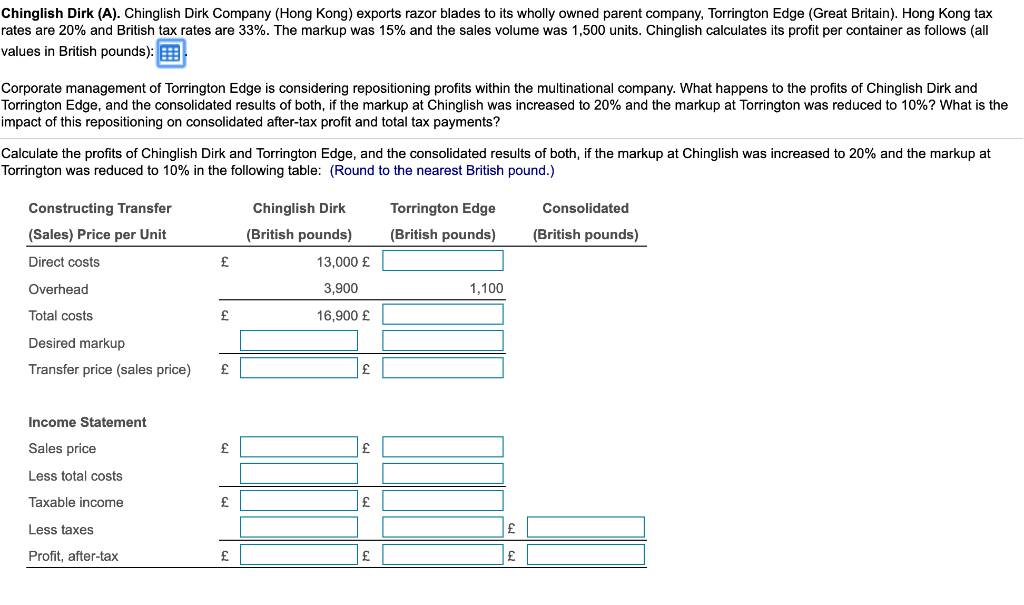

Chinglish Dirk (A). Chinglish Dirk Company (Hong Kong) exports razor blades to its wholly owned parent company, Torrington Edge (Great Britain). Hong Kong tax rates are 20% and British tax rates are 33%. The markup was 15% and the sales volume was 1,500 units. Chinglish calculates its profit per container as follows (all values in British pounds) Corporate management of Torrington Edge is considering repositioning profits within the multinational company. What happens to the profits of Chinglish Dirk and Torrington Edge, and the consolidated results of both, if the markup at Chinglish was increased to 20% and the markup at Torrington was reduced to 10%? What is the impact of this repositioning on consolidated after-tax profit and total tax payments? Calculate the profits of Chinglish Dirk and Torrington Edge, and the consolidated results of both, if the markup at Chinglish was increased to 20% and the markup at Torrington was reduced to 10% in the following table: (Round to the nearest British pound.) Constructing Transfer (Sales) Price per Unit Direct costs Overhead Total costs Desired markup Transfer price (sales price Torrington Edge (British pounds) (British pounds) British pounds) Chinglish Dirk Consolidated 13,000 3,900 16,900 1,100 Income Statement Sales price Less total costs Taxable income Less taxes Profit, after-tax -X 1 Data Table Chinglish Dirk (British pounds) (British pounds) (British pounds) Torrington Edge Consolidated Constructing Transter (Sales) Price per Unit Direct costs Overhead Total costs Desired markup Transfer price (sales price 13,000 3,900 16,900 2,535 19,435 19,435 1,100 20,535 3,080 23,615 Income Statement Sales price Less total costs 29,152,500 35,422,500 (25,350,000) (30,802,500) 4,620,000 (1,524,600) 3,095,400 3,802,500 (760,500) 3,042,000 laxable income 2,285,100 Less taxes 6,137,400 Profit, after-tax Chinglish Dirk (A). Chinglish Dirk Company (Hong Kong) exports razor blades to its wholly owned parent company, Torrington Edge (Great Britain). Hong Kong tax rates are 20% and British tax rates are 33%. The markup was 15% and the sales volume was 1,500 units. Chinglish calculates its profit per container as follows (all values in British pounds) Corporate management of Torrington Edge is considering repositioning profits within the multinational company. What happens to the profits of Chinglish Dirk and Torrington Edge, and the consolidated results of both, if the markup at Chinglish was increased to 20% and the markup at Torrington was reduced to 10%? What is the impact of this repositioning on consolidated after-tax profit and total tax payments? Calculate the profits of Chinglish Dirk and Torrington Edge, and the consolidated results of both, if the markup at Chinglish was increased to 20% and the markup at Torrington was reduced to 10% in the following table: (Round to the nearest British pound.) Constructing Transfer (Sales) Price per Unit Direct costs Overhead Total costs Desired markup Transfer price (sales price Torrington Edge (British pounds) (British pounds) British pounds) Chinglish Dirk Consolidated 13,000 3,900 16,900 1,100 Income Statement Sales price Less total costs Taxable income Less taxes Profit, after-tax -X 1 Data Table Chinglish Dirk (British pounds) (British pounds) (British pounds) Torrington Edge Consolidated Constructing Transter (Sales) Price per Unit Direct costs Overhead Total costs Desired markup Transfer price (sales price 13,000 3,900 16,900 2,535 19,435 19,435 1,100 20,535 3,080 23,615 Income Statement Sales price Less total costs 29,152,500 35,422,500 (25,350,000) (30,802,500) 4,620,000 (1,524,600) 3,095,400 3,802,500 (760,500) 3,042,000 laxable income 2,285,100 Less taxes 6,137,400 Profit, after-tax








